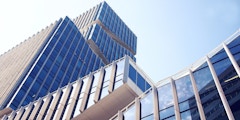
134 results
-

-

Exploring Heritage: Building on the Past
- Article by Mic Patterson
Welcome to this edition of the SKINS newsletter, which is all about carbon! As guest editor this month, I am representing FTI’s embodied carbon (EC) working group. This issue highlights several important topics relative to embodied and the trade-offs with operational carbon.
-

Carbon crisis: The embodied carbon challenge
- Article by Andrew Himes
The focus of this issue of SKINS is on embodied carbon -- the carbon dioxide (CO₂) emissions associated with materials and construction processes throughout the whole lifecycle of a building or infrastructure.
-
Kinetic Shading Systems
- Paper by Alireza Jahanara · Negar Kalantar
This study focuses on experiments in kinetics and architectural skins. More extensively, it introduces a solution for environmental design issues and
-
Delivering Beauty
- Paper by Michael Mulhern,
Amidst the critical conversations about the need to build better and more efficient building skins, designers are also mindful of the need for the… -
Facade Tectonics Institute Recognizes Industry Leaders with the Vitruvian Honors & Awards
- Article by Mic Patterson, PhD LEED AP+, Ambassador of Innovation & Collaboration
In this first 2022 issue of SKINS, we pause to look back on 2021 through our most-read stories of the year, which we’ve recycled here in case you missed them. The very first thing we see is the inaugural Vitruvian Honors & Awards (VH&A) program conducted virtually. It was a spectacular event!
-

Finally
- Paper by Michael Mulhern,
For over 60 years architects, engineers, and consultants have been specifying stainless steels for use in building skins and in some structural… -

Bridging the Gap Between the Facade Industry and Diversity
- Article by Raditia Lasry, Administrative Assistant & Mindfulness Guide
This newsletter is different from what you usually expect from SKINS. We are talking about human connection, communication, language, and broadening our understanding of how we move through the world and evolve with the new information we receive. How do these aspects relate to the AECO Industry?
-

2023 Vitruvian Awards
- Article by Rowan Georges, AIA · Daniel Arztmann, Prof. Dipl.-Ing. MEng
The first Vitruvian Honors & Awards program took place in 2021. The virtual program highlights the finalists in each project category.
-
Recent Adaptive Textile Façade Systems
- Paper by Lucio Blandini, Director, Full Professor Moon-Young Jeong, Doctoral Researcher Michael Voigt, Doctoral Researcher, IKTD, University of Stuttgart Jonathan Lopez, Doctoral Researcher Hannah Schürmann, Doctoral Researcher Arina Cazan, Research Assistant Hannah Raisch, Student Daniel Roth, Head of Research Group Methodical Product Development, IKTD, University of Stuttgart Maria Matheou, Junior Professor
Adaptive facade systems are a promising approach to achieve a dynamic response to varying weather conditions and user demands. The interdisciplinary… -

Stop F*cking Around – Build Our Zero Carbon Economy Now
- Article by Drew Shula
To avoid the worst effects of the climate crisis, we urgently need to reduce carbon emissions now. But that's not enough! This original article for SKINS by Drew Shula is a veritable manifesto on the why and how of climate action for all of us.
-
Facade Tectonics Institute Announces Second World Congress
- Press Release
The Facade Tectonics Institute will convene its second World Congress on March 12-13, 2018, in Los Angeles at the University of Southern California. The theme of this year’s conference, “Skins on Campus: Bridging Industry and Academia in Pursuit of Better Buildings and Urban Habitat,” focuses on the
-

Design Considerations and the Complex Facade
- Paper by Stan Su,
The design of complex, high-performance facades involves balancing attention towards principles of material selection, thermal and moisture… -

Thermal and Fire Characteristics of FRP Composites for Architectural Applications
- Article by Nicholas Dembsey
The advantages and challenges for FRP in architectural applications as discussed in our 2015 paper are still very much true today. As the advantages of FRP are discussed comprehensively elsewhere in this issue of SKINS, I will focus my comments on FRP fire behavior.
-

Explore the top papers from the 2020 World Congress
- Announcement
Each week leading up to the 2020 World Congress, we will announce one of the four winning authors, selected from the 118 papers to be presented at the virtual event, and releasing an interview with them on our SKINS Podcast.
-

Algorithmic Patterns for Facade Design
- Paper by Inês Caetano, António Leitão,
Recently, building envelopes have been exhibiting complex shapes and patterns, a trend supported by current digital technologies. Likewise, the… -

Surfing Uncertainty
- Article by Mic Patterson, PhD LEED AP+, Editor, SKINS
We are all swimming in the wake of Covid-19. There are signs that things are slowly beginning to open up, although serious concerns remain among health professionals that governments, under increasing pressure to restart the economy, may be acting prematurely.
-

Crucial Conversations of Diversity & Inclusion
- Article by William Green
In architecture, the façade is often the defining aspect of a building’s appearance, establishing the building’s public persona. From an engineering perspective, the façade is an assembly of building components with a critical impact on a range of performative metrics.
-

World Congress 2020: A Home Run!
- Article by Mic Patterson, PhD, LEED AP+
Facades Month and the World Congress, long delayed and virtually conducted, is now in the rear-view mirror with some of us still recovering from the experience. It was an intensive undertaking. And I tell you this, my friends: it was stupendous!
-

Event Passed
–Facades+ NYC
- New York City, United States
Facades+ bring together some of the world’s most productive building professionals. Be inspired and learn how to innovate all steps of facade implementation, from systems and materials to designs and delivery strategies.
Industry Event by The Architect's Newspaper
